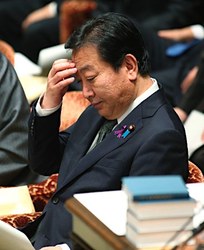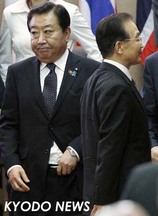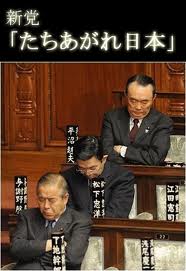 Source: studio-air.blogspot.com
Source: studio-air.blogspot.com The desire of both political personalities to join up before the general election forced some concessions out of Hashimoto as well, including a repeal on political parties receiving donations from corporate sponsors (apparently sparked by concerns from members of the Party of the Sun that they can’t contest an election without corporate funding) (J), along with a repeal of a ban on Reformist Party members simultaneously holding more than one official position (this refers to Hashimoto’s own ambitions for the national Diet. At present he cannot serve as both Mayor of Osaka and as a member of the House of Councillors. In an added twist, the Reform Party’s own eight point policy platform (launched in August) stated that the party would seek to abolish the upper house of Parliament. Apparently this too has fallen by the wayside lest Hashimoto make it to the Diet only to abolish his seat).
While Hashimoto and Ishihara have been sorting out their respective differences (as a short diversion, Ishihara addressed the Foreign Correspondents Club on Tuesday the 20th to give his support to Japan’s acquiring the capacity to run nuclear weapon simulations (E and J). Just how that sits with the Reform Party is unknown, but given Hashimoto’s previous comments in support of collective self-defence, probably not a point of contention between two bona-fide “hawks”). At present (27th of November), polling shows that the Reform Party is on course to becoming an viable alternative to the DPJ (J), thus raising the prospect of the LDP having to acquiesce with the Reformists on questions of fiscal responsibility, defence upgrades, and constitutional revision. Given the sympathy shared on both sides on these issues (not to mention PM Noda’s shift to a more strident nationalistic stance on territorial issues, a stance shared by those remaining DPJ members), Japanese politics could be about to get a lot more rightist. It should be noted, however, that this does not necessarily mean that the broader society will embrace nationalism, nor agree to a more confrontational approach to regional relations.
What this election promises in terms of highlights (if that is indeed possible) are the various proposals from the contenders on how to resolve Japan’s economic woes. First to throw his hat into the fiscal ring was Abe Shinzo, who announced that in order to revitalise the economy he would have the Bank of Japan issue a continuous series of easing solutions to stimulate the economy and bring inflation up to a target of 2%. While Abe has retreated from earlier statements that in order to bring the BoJ and the LDP into sync, the LDP would consider revising the law guaranteeing central bank neutrality from the federal government (“Party leaders diverge on best plan for Japan”, The Australian, November 26 2012, p.24), his faith in easing has not wavered despite all evidence that it is, at best, a temporary measure and would further add to Japan’s already astronomic levels of public debt (a dip in the yen after Abe announced his policy was taken as proof, by Abe, that the market favoured his strategy, yet its rebound thereafter went unnoticed).
Abe’s insistence on monetary easing as a means to recovery, and his comments on reducing the independence of the BoJ had BoJ Chairman Shirakawa Masaaki concerned enough to state in public that the BoJ’s neutrality should be respected and that quantitative easing in itself could not cure all of Japan’s financial ills. Given that Shirakawa has advocated a more robust series of reforms, including de-regulation and higher workforce participation by women, he is regarded as a “maverick” by Japan’s conservative political classes who have continued to rely on outdated models of fiscal stimulation out of fear of what more fundamental economic and social reforms might unleash (“Monetary policy no cure-all for Japan”, AFR November 26 2012, p.31). As such, expectations are that should Abe be voted in as PM, Shirakawa will be one of the first public officials to go, and will be replaced with someone more “compliant” to the LDP’s only strategy for growth (as an aside, the LDP is, in principle, opposed to the TPP as a result of the impact that the trade pact could have on the LDP’s traditional rural support base, and will only agree to it if certain sectors of the Japanese economy remain tariff-bound, thereby undermining the purpose of the TPP).
Abe’s questionable economic program is also raising eyebrows within the Keidanren (Japan Federation of Economic Organisations), if comments by Keidanren President Yonekura Hiromasa are anything to go by. When asked for his opinion on Abe’s strategy of monetary easing, Yonekura replied that “it’s more reckless than grand”, adding that for a party to consider using an economic strategy banned by other countries amounted to little more than foolhardiness (J, although the fact that Yonekura said this while in China to participate in “friendship” discussions with Chinese counterparts might have been an attempt to separate him from Abe’s more nationalistic rhetoric).
At least Abe can be congratulated for actually putting a growth policy forward, unlike the other parliamentary parties whose own economic policies seem retrogressive, if not downright anti-growth, namely: anti-TPP (is it better to sacrifice belonging to an free trade agreement so as to protect an unprofitable, aging domestic sector?), anti-nuclear (understandable, but what are the alternatives? Solar? Wind? If you think electricity prices are expensive now, they’ll be diabolical during the process of switching to sustainable energy sources), and anti-tax increases (social restructuring might take care of this, but good luck getting the major parties to agree to upsetting business and industry by dismantling pro-business work practices, not to mention abandoning 20 years of debate and a final agreement to raise the consumption tax rate). In the case of the Communist Party, you could add anti-US to that as well, but I digress.
In short, expectations with regard to the major parties in this election are not high, given the track record of both the LDP and DPJ. While the Reformists promise change, they may be too extreme for many Japanese citizens to accept as the main opposition party. Minority parties may come to exercise more influence on government than in the previous Parliament (for better or worse), while the fiscal situation of the nation will not improve without more radical departures from existing methods for growth.



 RSS Feed
RSS Feed